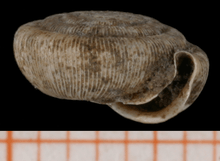Trissexodontidae
Trissexodontidae is a family of air-breathing land snails, terrestrial pulmonate gastropod mollusks in the superfamily Helicoidea (according to the taxonomy of the Gastropoda by Bouchet & Rocroi, 2005).
| Trissexodontidae | |
|---|---|
 | |
| Apertural view of the shell of Trissexodon constrictus. Scale is in mm. A regularly ribbed shell is one of the characteristics of this family. | |
| Scientific classification | |
| Kingdom: | Animalia |
| Phylum: | Mollusca |
| Class: | Gastropoda |
| Subclass: | Heterobranchia |
| Superorder: | Eupulmonata |
| Order: | Stylommatophora |
| Suborder: | Helicina |
| Infraorder: | Helicoidei |
| Superfamily: | Helicoidea |
| Family: | Trissexodontidae H. Nordsieck, 1987[1] |
| Genera | |
|
See text | |
| Synonyms[2] | |
| |
This family has no subfamilies.[2] The family Trissexodontidae was separated out from the families Hygromiidae and Helicodontidae,[2] and some authors still classify these species within those families.
Distribution
The distribution of Trissexodontidae includes the Iberian peninsula, northwest Africa,[4] Azores,[5] Canary Islands, Madeira and Cape Verde.[6]
Genera
Genera within the family Trissexodontidae include:
- Caracollina Beck, 1837[4]
- Gasullia Ortiz de Zárate López, 1962[4]
- Gasulliella Gittenberger, 1980[4] - with only one species, Gasulliella simplicula (Morelet, 1845)
- Gittenbergeria Schileyko, 1991[4]
- Mastigophallus Hesse, 1918[4] - with only one species, Mastigophallus rangianus (Michaud, 1831)
- Oestophora Hesse, 1907[4]
- Oestophorella Pfeffere, 1929[4]
- Trissexodon Pilsbry, 1895[4] - type genus of the family Trissexodontidae
- Spirorbula Lowe, 1852 - probable classification,[4] from Madeira and Porto Sancto[7]
- Suboestophora Ortiz de Zárate López, 1962[8]
Description
Shells of species in the family Trissexodontidae are flat and regularly ribbed. The periostracum of the shell surface has no hairs.[4]
A description of the reproductive system was summarized by Prieto et al. (1993).[4]
In this family, the number of haploid chromosomes is known only for the genus Oestophora (n=30).[4]
References
- (in German) Nordsieck H. (1987). "Revision des Systems der Helicoidea (Gastropoda: Stylommatophora)". Archiv für Molluskenkunde 118(1-3): 9-50. page 30.
- Bouchet, Philippe; Rocroi, Jean-Pierre; Frýda, Jiri; Hausdorf, Bernard; Ponder, Winston; Valdés, Ángel & Warén, Anders (2005). "Classification and nomenclator of gastropod families". Malacologia. Hackenheim, Germany: ConchBooks. 47 (1–2): 1–397. ISBN 3-925919-72-4. ISSN 0076-2997.
- Schileyko A. A. (1991). "Taxonomic status, phylogenetic relations and system of the Helicoidea sensu lato (Pulmonata)". Archiv für Molluskenkunde 120(4-6): 187-236. page 225.
- Prieto C. E., Puente A. I, Altonaga K. & Gomez J. (1993). "Genital morphology of Caracolina lenticula (Michaud, 1831), with a new proposal of classification of helicodontoid genera (Pulmonata: Hygromioidea)". Malacologia 35(1): 63-77. page 73-74.
- "Genus summary for Oestophora". AnimalBase, last modified 17 July 2008, accessed 13 January 2011.
- "Genus summary for Caracollina". AnimalBase, last modified 17 August 2007, accessed 13 January 2011.
- "Genus taxon summary for Spirorbula". AnimalBase, last modified 09 September 2008, accessed 13 January 2011.
- "Suboestophora Ortiz de Zarate Lopez 1962". Fauna Europaea, accessed 13 January 2011.
External links
| Wikimedia Commons has media related to Trissexodontidae. |